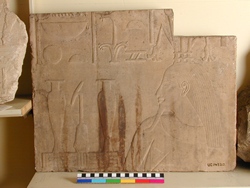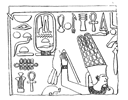'Temple syntax'
Commentators such as Philippe Derchain have used the term 'temple syntax' (grammaire du temple) to foster awareness of the intricate construction of meaning and deployment of symbol and form across the walls and columns of the rectilinear temple in ancient Egypt. This phrase, in common with other structuralist interpretations, carries risks; it may assume a privileged status for the written word, under the modern concept of 'text', over other aspects of architecture and religion. This is a particular danger in academic research, because universities train students precisely in the production and consumption of the printed and now digitised word. However, as with structuralist approaches in general, the notion of a 'temple syntax' has been productive, because it defines a clear object of study.
| reconstruction of temple of Amenhotep III (?) and Ramesses II at Memphis, one of the largest rectilinear temple precincts, now much destroyed |
The 'reading of the temple' has been applied to the most prominent type of surviving religious architecture from ancient Egypt, the formal rectilinear temple: note though the variety in temple architecture.
Orientation
Within a rectilinear temple, the focus falls on the place where the image of the deity would stand in its shrine. This place is equated with the primeval mound, and is kept sacred by its separation from the human world; it is dark, the room is the narrowest, the ground is at its highest, and the ceiling at its lowest. Only the king and his delegate, the offerer, could enter this space. On the idealised temple section shown below, the shrine is at the right end, the pylon towers of the entrance at the left.
![]()
Moving out from the darkness of the shrine, the next chamber was slightly lower, with more light admitted, and then the next might be a columned hall with closed floral columns, and the next space might be a broad court open to the sky, with open floral columns.
The ceilings bear stars, and the upper border of a wall might bear the hieroglyphic motif used in the script to write the Egyptian word Xkr 'adornment'.
The lower courses of the walls evoked the plants emerging at the beginning of creation from the primeval waters, and from the fertile Nile silt, with a rhythmic register of offering-bearing androgynous figures, each the Nile flood (in Egyptian Hapy), often one for each of the provinces of Egypt. Plants and Hapy figures underpin the temple ritual, as the farmland and produce underpinned the existence of the temple and of Egypt.
 |
Raised relief block, perhaps of early New Kingdom date, from a temple structure at Koptos, destroyed in antiquity; depiction of the Nile flood (Hapy) personified as a man with pendulous breasts, bearing offerings |
Above these registers, the scenes depicted on the walls capture in two dimensions and for eternity the offering ritual. Until the end of temple-building in the ancient Egyptian tradition, in the third century AD, only hieroglyphic script and formal art was able to achieve this; the development of bodily perspective in ancient Greek art in the fifth century BC left no impression in this space, because perspective has other functions - it was evidently not useful for the specific temple function of obtaining eternal life for the offering ritual.
Each scene on a wall presented the world in one action; accordingly, its upper border might take the form of a sky-hieroglyph, and its lower border might be a plain band with rounded ends, the form the hieroglyph for 'earth'. The sky and earth hieroglyphs might be joined by another hieroglyph, the sceptre reading in Egyptian wAs 'power'.
Identify some of those elements on the following fragments from Koptos. Which is missing?
 |
 |
Within each scene on a wall, a single episode is shown, usually depicting the reigning king offering before the deity, sometimes a festival scene. Since ideally the king performed every action in every cult place in Egypt, only the king is shown; no delegate, even the highest 'priest' of the temple, is ever shown making the offering in these internal temple contexts.
Within each scene on a wall, the depiction of the deity is always on the side nearer the position of the cult image of the deity in the temple, while the king making the offering is depicted nearer the position of the door by which he entered; therefore, in a temple with the shrine at the east end, such as the temple of Amun at Karnak, the following rules of orientation apply:
This is so strictly followed, that it is possible to locate a fragment on north or south side even when the rest of the temple has been destroyed.
Where do the following fragments belong - on the north or south wall?
The content of each scene also obeys principles of orientation: crowns, deities, and peoples connected with the north are found on the north wall of a temple, and those connected with the south are on the south wall, whether the shrine is at east or west end of the axis.
Larger structures in more comprehensively decorated rectilinear temples provided opportunities for elaborating on this system, and artists produced increasingly complex forms for crowns, and increasingly intricate interplay between offering scenes in different corners of chambers, and on different sides of walls. Nothing is a product of chance; even the epithet for the name of the king follows some principle of selection that may be decoded - in the inscriptions of the Great Hypostyle Hall of the Amun temple at Karnak, occurrences of the epithet 'beloved of Ptah' can be joined over the space to trace the route taken by the individuals bearing offerings for a chapel of the god Ptah to the north of the Amun temple.
Copyright © 2003 University College London. All rights reserved.